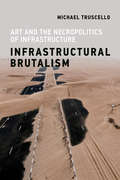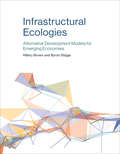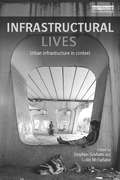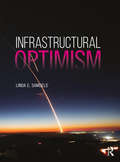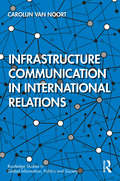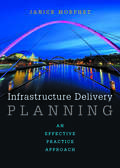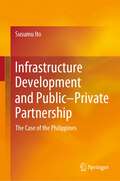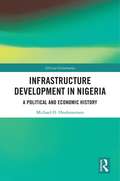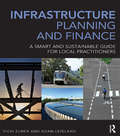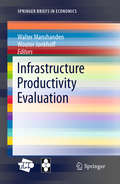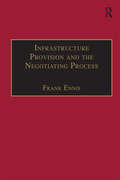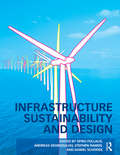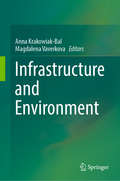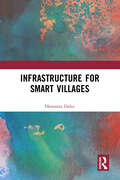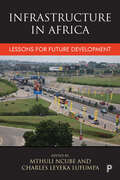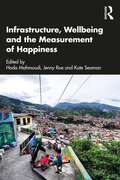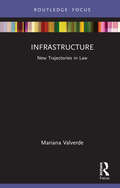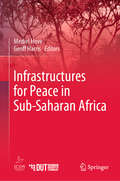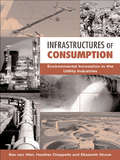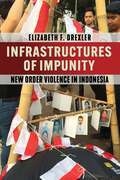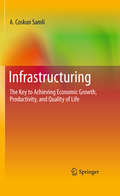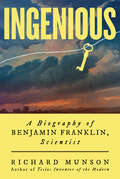- Table View
- List View
Infrastructural Brutalism: Art and the Necropolitics of Infrastructure (Infrastructures)
by Michael TruscelloHow "drowned town" literature, road movies, energy landscape photography, and "death train" narratives represent the brutality of industrial infrastructures. In this book, Michael Truscello looks at the industrial infrastructure not as an invisible system of connectivity and mobility that keeps capitalism humming in the background but as a manufactured miasma of despair, toxicity, and death. Truscello terms this "infrastructural brutalism"--a formulation that not only alludes to the historical nexus of infrastructure and the concrete aesthetic of Brutalist architecture but also describes the ecological, political, and psychological brutality of industrial infrastructures.
Infrastructural Ecologies: Alternative Development Models for Emerging Economies (The\mit Press Ser.)
by Hillary Brown Byron StiggeAn integrated, holistic model for infrastructure planning and design in developing countries.Many emerging nations, particularly those least developed, lack basic critical infrastructural services—affordable energy, clean drinking water, dependable sanitation, and effective public transportation, along with reliable food systems. Many of these countries cannot afford the complex and resource-intensive systems based on Western, single-sector, industrialized models. In this book, Hillary Brown and Byron Stigge propose an alternate model for planning and designing infrastructural services in the emerging market context. This new model is holistic and integrated, resilient and sustainable, economical and equitable, creating an infrastructural ecology that is more analogous to the functioning of natural ecosystems.Brown and Stigge identify five strategic infrastructure objectives and illustrate each with examples of successful projects from across the developing world. Each chapter also highlights exemplary preindustrial systems, demonstrating the long history of resilient, sustainable infrastructure. The case studies describe the use of single solutions to solve multiple problems, creating hybridized and reciprocal systems; “soft path” models for water management, including water reuse and nutrient recovery; post carbon infrastructures for power, heat, and transportation such as rural microhydro and solar-powered rickshaws; climate adaptation systems, including a multi-purpose tunnel and a “floating city”; and the need for community-based, equitable, and culturally appropriate projects.
Infrastructural Lives: Urban Infrastructure in Context
by Stephen Graham Colin McFarlaneInfrastructural Lives is the first book to describe the everyday experience and politics of urban infrastructures. It focuses on a range of infrastructures in both the global South and North. The book examines how day-to-day experience and perception of infrastructure provides a new and powerful lens to view urban sustainability, politics, economics, cultures and ecologies. An interdisciplinary group of leading and emerging urban researchers examine critical questions about urban infrastructure in different global contexts. The chapters address water, sanitation, and waste politics in Mumbai, Kampala and Tyneside, analyse the use of infrastructure in the dispossession of Palestinian communities, explore the pacification of Rio’s favelas in the run-up to the 2014 World Cup, describe how people’s bodies and lives effectively operate as ‘infrastructure’ in many major cities, and also explores tentative experiments with low-carbon infrastructures. These diverse cases and perspectives are connected by a shared sense of infrastructure not just as a ‘thing’, a ‘system’, or an ‘output,’ but as a complex social and technological process that enables – or disables – particular kinds of action in the city. Infrastructural Lives is crucial reading for academics, researchers, students and practitioners in urban studies globally.
Infrastructural Optimism
by Linda C. SamuelsInfrastructural Optimism investigates a new kind of twenty-first-century infrastructure, one that encourages a broader understanding of the interdependence of resources and agencies, recognizes a rightfully accelerated need for equitable access and distribution, and prioritizes rising environmental diligence across the design disciplines. Bringing together urban history, case studies, and speculative design propositions, the book explores and defines infrastructure as the basis for a new form of urbanism, emerging from the intersection of architecture, landscape architecture, and urban design. In defining this new infrastructure, the book introduces new dynamic and holistic performance metrics focused on "measuring what matters" over growth for the sake of growth and twelve criteria that define next generation infrastructure. By shifting the focus of infrastructure – our largest public realm – to environmental symbiosis and quality of life for all, design becomes a catalytic component in creating a more beautiful, productive, and optimistic future with Infrastructural Urbanism as its driver. Infrastructural Optimism will be invaluable to design, non-profit and agency professionals, and faculty and students in the fields of architecture, landscape architecture, and urban design, working in partnership with engineers, hydrologists, ecologists, urban planners, community members, and others who shape the built environment through the expanded field of infrastructure.
Infrastructure Communication in International Relations (Routledge Studies in Global Information, Politics and Society)
by Carolijn van NoortThis book demonstrates how infrastructure projects and the communications thereof are strategized by rising powers to envision progress, to enhance the actor’s international identity, and to substantiate and leverage the actor’s vision of international order. While the physical aspects of infrastructure are important, infrastructure communication in international relations demands more scholarly attention. Using a case-study approach, Carolijn van Noort examines how rising powers communicate about infrastructure internationally and discusses the significance of these communication practices. The four case studies include BRICS’s summit communications about infrastructure, Brazil’s infrastructure promises to Africa, China’s communication of the Belt and Road Initiative in East Africa, and Kazakhstan’s news media coverage of China’s Belt and Road Initiative. Van Noort highlights the fact that the link between infrastructure, identity, and order-making is arbitrary and thus contested in practice, with rising powers operationalizing infrastructure communication in international relations in varied ways. She argues that both communication organization and the visuality of strategic narratives on infrastructure influence the international communication of infrastructure vision and action plans, with different levels of success. Infrastructure Communication in International Relations is a welcome and timely book of interest to students and scholars in the fields of international relations, global communications, and the politics of infrastructure.
Infrastructure Delivery Planning: An Effective Practice Approach
by Janice MorphetThis important text book is the first to be written about infrastructure planning in Britain. Written by an experienced author, the book reviews the rapid rise in the use of infrastructure delivery planning at national and neighbourhood level. The key components of infrastructure delivery are set out and analysed, including the development of government policy, planning regulation, funding, environmental processes and legal challenges. Situating this within international, European and domestic economic, territorial and social policy, the author draws on a variety of practical examples to discuss the role of different institutions in the delivery of infrastructure and to illustrate the various issues and merits of each approach. This is a key text for those engaged in the study and application of infrastructure delivery planning including planners, engineers, public administrators and policy advisers.
Infrastructure Development and Public–Private Partnership: The Case of the Philippines
by Susumu ItoThis is the first book that analyzes public–private partnership (PPP) infrastructure development in developing countries by focusing on recent developments in the Philippines.Infrastructure is extremely important for economic development and poverty reduction. However, given the infrastructure gap and pressures on public expenditure, there is a growing expectation that PPP will fill this gap globally. Over the years, PPP as a mechanism for financing and procuring infrastructure has been the basis of an active and provocative debate in the Philippines, which is known to have inadequate infrastructure—twice in the 2010s, when a significant policy shift on the financing source of public infrastructure was announced by the Philippine government. Drastic policy changes concerning the roles of public finance and PPP in infrastructure development within this decade are not seen in other developing countries.There is no precedent for substantial study on the changes of infrastructure governance in the Philippines, but this book assesses policy changes in infrastructure development in the country and, as academic contributions, identifies several factors behind the changes related to infrastructure governance there, especially the drastic shifts during the Aquino III and Duterte administrations. Furthermore, the findings presented in the book, including the desirable role of public finance and PPP in developing infrastructure in developing countries, could improve infrastructure governance, such as choice of the financing mode, design, and implementation of the PPP project, in other developing countries as an operable contribution to policymakers of government and to industry and management practitioners.
Infrastructure Development in Nigeria: A Political and Economic History (African Governance)
by Michael O. OnolememenThis book examines the politics and economics of infrastructure development in Nigeria from Independence in 1960 up to 2015, and the role of good governance in promoting the socioeconomic wellbeing of citizens. Arguing for the need for transformational leadership in infrastructure development, the chapters examine policy issues and survey the various administrative, economic, and social-political reforms that have impacted infrastructure development in Nigeria. The author also discusses current national development plans and Vision 20:2020; challenges to infrastructure development, including corruption; and the future potential of a strong infrastructure network for the economy and citizens. Drawing upon his experience within government departments, as well as existing models of leadership and governance, the author explores the role of infrastructure development in promoting the wellbeing and growth of Nigeria. Combining theory with practical examples of good governance, this book will be of interest for students and researchers of political science and infrastructure development in Africa.
Infrastructure Planning and Finance: A Smart and Sustainable Guide
by Vicki Elmer Adam LeiglandInfrastructure Planning and Finance is a non-technical guide to the engineering, planning, and financing of major infrastucture projects in the United States, providing both step-by-step guidance, and a broad overview of the technical, political, and economic challenges of creating lasting infrastructure in the 21st Century. Infrastructure Planning and Finance is designed for the local practitioner or student who wants to learn the basics of how to develop an infrastructure plan, a program, or an individual infrastructure project. A team of authors with experience in public works, planning, and city government explain the history and economic environment of infrastructure and capital planning, addressing common tools like the comprehensive plan, sustainability plans, and local regulations. The book guides readers through the preparation and development of comprehensive plans and infrastructure projects, and through major funding mechanisms, from bonds, user fees, and impact fees to privatization and competition. The rest of the book describes the individual infrastructure systems: their elements, current issues and a 'how-to-do-it' section that covers the system and the comprehensive plan, development regulations and how it can be financed. Innovations such as decentralization, green and blue-green technologies are described as well as local policy actions to achieve a more sustainable city are also addressed. Chapters include water, wastewater, solid waste, streets, transportation, airports, ports, community facilities, parks, schools, energy and telecommunications. Attention is given to how local policies can ensure a sustainable and climate friendly infrastructure system, and how planning for them can be integrated across disciplines.
Infrastructure Productivity Evaluation
by Walter Manshanden Wouter JonkhoffInfrastructure construction and use is at the heart o the current political debate. Not only are European member state governments investing large amounts of money to alleviate the harmful effects of the economic downturn due to the credit crisis, EU accession countries receive large amounts of cohesion funds for infrastructure purposes. Infrastructure is widely believed to contribute largely to economic performance, but to what extent is this the case? How does the productivity of roads, railways and ports relate to the invested money, and what determines their effectiveness? In this Brief, which focuses to a large extent on Dutch and European practice, numerous distinguished economists describe policy practice and analytical tools for infrastructure appraisal. Moreover, harmonisation of European approaches for evaluation of infrastructure are discussed. The study focuses both on scientific productivity measurement as on case studies of infrastructure policy.
Infrastructure Provision and the Negotiating Process (Urban and Regional Planning and Development Series)
by Frank EnnisThe provision of infrastructure for urban developments is increasingly becoming a highly contentious and important issue in planning negotiations. By drawing together a range of case studies from North America, Australia and Europe, this book compares how a number of planning systems deal with this issue. There is a general trend by planning agencies towards the securing of infrastructure from the private sector. This necessitates a negotiation process between planning agencies, developers and infrastructure providers and this volume shows how this process varies according to the political context, the nature of the planning system and the existence of other frameworks such as Environmental Impact Assessment. By doing so, the collection presents an original perspective on both the negotiation process in planning and on how infrastructure should be provided.
Infrastructure Sustainability and Design
by Andreas Georgoulias Daniel Schodek Spiro Pollalis Stephen RamosYou're overseeing a large-scale project, but you're not an engineering or construction specialist, and so you need an overview of the related sustainability concerns and processes. To introduce you to the main issues, experts from the fields of engineering, planning, public health, environmental design, architecture, and landscape architecture review current sustainable large-scale projects, the roles team members hold, and design approaches, including alternative development and financing structures. They also discuss the challenges and opportunities of sustainability within infrastructural systems, such as those for energy, water, and waste, so that you know what's possible. And best of all, they present here for the first time the Zofnass Environmental Evaluation Methodology guidelines, which will help you and your team improve infrastructure design, engineering, and construction.
Infrastructure and Environment
by Anna Krakowiak-Bal Magdalena VaverkovaThis book constitutes the 25th International Conference on Infrastructure and Environment (infraeco 2018) that focuses on rural problems connected with infrastructural equipment.In general, infrastructure issues are dedicated to urban areas while rural topics are linked to agriculture so this conference bridges these two aspects. It also explores ways to manage and separate conflicts between different and important needs of inhabitants, the environment, and other spatial users.The conference provides a forum for much needed cooperation between various scientific disciplines regarding these multidisciplinary problems and issues; hence, Infraeco 2018 draws together engineers, planners, consultants, land developers, and academics from across all disciplines of highway planning, design, operations, and engineering to presents effective practices and share current research results.
Infrastructure for Smart Villages
by Hemanta DoloiThis book intends to initiate a fresh articulation of need-based infrastructure provisions in rural contexts. Departing from the conventional theories and practices of infrastructure planning and development applied in urban settings, the book presents a comprehensive suite of technical and non-technical indicators that rationalise fit-for-purpose planning, development, and operations of rural infrastructure. Drawing from global practices in public and private sectors and research-based evidence, a distinctive argument is put forward for promoting location-specific infrastructure development from effectiveness, practicality, affordability, and sustainability perspectives. The argument encompasses wider social, cultural, and economic contexts that are unique to rural settings and the book highlights a clear roadmap of how the UN’s sustainable development goals (SDGs) are at the core of developing rural communities with necessary infrastructure provisions that are purpose-built, affordable, risk averse, and resilient.This book will provide an overview of some of the little-understood and sometimes counter-intuitive best practices on rural infrastructure and value-based priorities that have emerged in uplifting rural communities in developing economies over the last 30 years. Drawing from the global literature and practice-based evidence across a complete spectrum of relevant disciplines, this book will provide readers with a clear articulation of the innovative ideas around harnessing rural potential, and empowering rural communities with added support in growth and progressive development in the context of interconnected infrastructure systems and improved living standards. It is key reading for development, planning, and infrastructure courses as well as professionals and researchers involved in international development, aid, and provision in rural areas.
Infrastructure in Africa: Lessons for Future Development
by Mthuli Ncube & Charles Leyeka LufumpaGood infrastructure is essential for socio-economic growth and sustainable development. Safe and accessible water supplies, reliable energy, good transport networks and communications technology are all vital to a region’s development agenda. This book presents a comprehensive exploration of the state of infrastructure in Africa and provides an integrated analysis of the challenges the sector faces, based on extensive fieldwork across the continent. Contributors with a wide range of expertise challenge current policy, practice and thinking on issues including the politics of infrastructure development, social inclusion, domestic resource mobilisation and infrastructure financing. The book will be an important resource for academic researchers, students and early career development professionals as well as policymakers and NGOs engaged in dialoguing the infrastructure development options for Africa.
Infrastructure, Wellbeing and the Measurement of Happiness
by Roe Jenny Seaman Kate Mahmoudi HodaThis book takes an interdisciplinary approach to our understanding of infrastructure, and it’s influence on happiness and wellbeing, by examining the concept from economic, human development, architectural, urban planning, psychological, and ethical points of view. Providing insights from both research and practice the volume discusses how to develop happier cities and improve urban infrastructure for the wellbeing of the whole population. The book puts forth the argument that it is only in understanding the true nature of infrastructure’s reach – how it connects, supports, and enlivens human beings – that we can truly begin to understand infrastructure’s possibilities. It connects infrastructure to that most elusive of human qualities – happiness – examining the way infrastructure is fundamentally tied to human values and human well-being. The book seeks to suggest novel approaches, identify outmoded undertakings, and define new possibilities in order to maximize infrastructure’s impact for all people – with a focus on diversity, inclusion and equity. In seeking to define infrastructure broadly and examine its possibilities systematically this book brings together theory and evidence from multiple disciplinary perspectives including, sociology, urban studies, architecture, economics, and public health in order to advance a startling claim – that our lives, and the lives of others, can be substantively improved by greater adhesion to the principles and practices of infrastructure design for happiness and wellbeing.
Infrastructure: New Trajectories in Law (New Trajectories in Law)
by Mariana ValverdeThis book provides an overview and assessment of infrastructure’s legal and governance underpinnings. Infrastructure is often thought of as a term referring only to the physical entities – pipes, cables, utility poles, highways, airports – that facilitate the transmission of water, gas, telecommunications and electricity, as well as enabling both private and public transportation, and serving to house more or less public services such as health care and schools. However, infrastructure planning and implementation are not reducible to bricks and mortar. The complex process requires drawing from and sometimes re-inventing or recycling legal tools, from construction contracts to financing ‘deals’, which are often taken for granted by both practitioners and urban studies scholars. These are as important today as they were when the first railway lines were built, and to a large extent they remain just as invisible: the avalanche of drawings and photographs of planned or in-process fancy buildings tends to hide from view the behind- the-scenes negotiations and decision-making that had to happen before construction could start, and which in some cases continue afterwards. This book does not ignore the material and nonhuman aspects of infrastructure. But, focusing on the legal and governance underpinnings of infrastructure projects, via a series of key terms that refer to hybrid legal processes, the book offers an important socio-legal supplement to the current ‘infrastructure turn’. This book will be of interest to students in the areas of socio-legal studies, urban sociology, urban studies, urban geography, planning, public law, and contract law, as well as practitioners involved in infrastructure projects.
Infrastructures for Peace in Sub-Saharan Africa
by Mediel Hove Geoff HarrisCultures of violence are characteristic of many countries in sub-Saharan Africa and attempts to move towards cultures of peace have often proved difficult and ineffectual. And yet, the wide variations in levels of violence within and between countries show that it is not inevitable; rather, it is the result of choices made at individual, community and societal levels. This book examines the potential of peace infrastructures as vehicles to strengthen and spread progress towards cultures of peace. Peace infrastructures vary hugely in sophistication and level. The examples examined in this book range from tiny structures which help resolve conflicts between individuals and within community organisations, peace committees which serve local communities, peace education and peace club programmes in schools, mediation mechanisms to prevent election violence and to ministries of peace to coordinate government and non-government efforts in peacemaking and peacebuilding. The overall finding is that the development of peace infrastructures at all levels has great potential to build cultures of peace. 1. It is the only book available which documents the experience and potential of nonviolence in post-independence sub-Saharan Africa. 2. It makes a persuasive case for the development of various peace infrastructures in order to make peace sustainable. 3. It explains how strategic planning can be utilised, both to bring about change and to institutionalise it.
Infrastructures of Consumption: Environmental Innovation in the Utility Industries
by Elizabeth Shove Bas Van Vliet Heather ChappellsFor many years, a uniform and uncontested picture of utility system organization has endured across Europe. Provider and consumer roles have been largely taken for granted, and consumers have had little choice but to use the infrastructure of the only network provider available. Recent transformations have challenged this model. This book examines the ongoing environmental restructuring of consumption and provision in energy, water and waste systems. In accounting for the distinctive environmental qualities, technical features, and institutional dynamics of utility systems this book challenges contemporary conceptualizations of consumers as the autonomous drivers of environmental change. Instead, utilities and users are positioned as the 'co-managers' of utility systems, and processes of environmental innovation are seen to depend on the systemic restructuring of demand.
Infrastructures of Impunity: New Order Violence in Indonesia (Cornell Modern Indonesia Project)
by Elizabeth F. DrexlerIn Infrastructures of Impunity Elizabeth F. Drexler argues that the creation and persistence of impunity for the perpetrators of the Cold War Indonesian genocide (1965–66) is not only a legal status but also a cultural and social process. Impunity for the initial killings and for subsequent acts of political violence has many elements: bureaucratic, military, legal, political, educational, and affective. Although these elements do not always work at once—at times some are dormant while others are ascendant—together they can be described as a unified entity, a dynamic infrastructure, whose existence explains the persistence of impunity. For instance, truth telling, a first step in many responses to state violence, did not undermine the infrastructure but instead bent to it. Creative and artistic responses to revelations about the past, however, have begun to undermine the infrastructure by countering its temporality, affect, and social stigmatization and demonstrating its contingency and specific actions, policies, and processes that would begin to dismantle it. Drexler contends that an infrastructure of impunity could take hold in an established democracy.
Infrastructuring
by A. Coskun SamliThe recent global financial crisis has intensified concerns over how nations--both developed and developing -- can revitalize economic growth and ensure opportunity for prosperity to all citizens. Many analysts and policymakers alike are looking to new business creation and the promotion of entrepreneurial practices as a panacea, or at least as a partial solution. A. Coskun Samli has argued in his two most recent books that the current model of globalization tends to marginalize the poor and that developing countries must rely on local business development, rather than exogenous forces, such as aid, loans, and trade, to catalyze growth. This third book in his trilogy argues that a "bottom-up" approach is necessary for developing countries to participate in globalization--but is not sufficient. He proposes that the economic goals of a country, a region, or a company are fulfilled first and foremost by a properly designed and maintained infrastructure, encompassing both physical elements, such as transportation and communication systems, and qualitative elements, such as functioning educational, legal, and governing institutions. In Infrastructuring, Samli analyzes the experiences of a variety of countries, including China, India, Ireland, and South Africa, to highlight the role that infrastructure plays in economic development, and considers its implications for such timely issues as new business creation, productivity, and supply chain logistics. Moreover, he outlines practical approaches to infrastructure management and policy oversight.
Inge & Mira
by Marianne Fredriksson'Themes of motherhood, lost identity and the past have resonance and relevance ... The tremulous, delicate process of friendship is beautifully handled' SUNDAY TIMES'A poignant, beautifully written book' THE LADYInge is tall and cool and Mira is petite and dynamic. When they meet, each is attracted by something special and different about the other. But friendships based on the attraction of opposites can be stormy, and theirs is no exception. Blonde Inge is a native of Sweden, while dark Mira has fled there to escape the living hell of Chile at the time of the military coup led by General Pinochet. They are brought together by their mutual love of plants, but this gentle pastime is soon overshadowed by the terrible legacy of Mira's past. It is a legacy that will reach out to touch many lives, including those of Inge and Mira's children. Written with sympathy and insight and sparkling with unexpected humour, INGE & MIRA is a deeply moving tale of lives haunted by past violence.
Inge & Mira
by Marianne Fredriksson'Themes of motherhood, lost identity and the past have resonance and relevance ... The tremulous, delicate process of friendship is beautifully handled' SUNDAY TIMES'A poignant, beautifully written book' THE LADYInge is tall and cool and Mira is petite and dynamic. When they meet, each is attracted by something special and different about the other. But friendships based on the attraction of opposites can be stormy, and theirs is no exception. Blonde Inge is a native of Sweden, while dark Mira has fled there to escape the living hell of Chile at the time of the military coup led by General Pinochet. They are brought together by their mutual love of plants, but this gentle pastime is soon overshadowed by the terrible legacy of Mira's past. It is a legacy that will reach out to touch many lives, including those of Inge and Mira's children. Written with sympathy and insight and sparkling with unexpected humour, INGE & MIRA is a deeply moving tale of lives haunted by past violence.
Ingenious Citizenship: Recrafting Democracy for Social Change
by Charles T. LeeIn Ingenious Citizenship Charles T. Lee centers the daily experiences and actions of migrant domestic workers, sex workers, transgender people, and suicide bombers in his rethinking of mainstream models of social change. Bridging cultural and political theory with analyses of film, literature, and ethnographic sources, Lee shows how these abject populations find ingenious and improvisational ways to disrupt and appropriate practices of liberal citizenship. When voting and other forms of civic engagement are unavailable or ineffective, the subversive acts of a domestic worker breaking a dish or a prostitute using the strategies and language of an entrepreneur challenge the accepted norms of political action. Taken to the extreme, a young Palestinian woman blowing herself up in a Jerusalem supermarket questions two of liberal citizenship's most cherished values: life and liberty. Using these examples to critically reinterpret political agency, citizenship practices, and social transformation, Lee reveals the limits of organizing change around a human rights discourse. Moreover, his subjects offer crucial lessons in how to turn even the worst conditions and the most unstable positions in society into footholds for transformative and democratic agency.
Ingenious: A Biography of Benjamin Franklin, Scientist
by Richard MunsonThe dramatic story of an ingenious man who explained nature and created a country. Benjamin Franklin was one of the preeminent scientists of his time. Driven by curiosity, he conducted cutting-edge research on electricity, heat, ocean currents, weather patterns, chemical bonds, and plants. But today, Franklin is remembered more for his political prowess and diplomatic achievements than his scientific creativity. In this incisive and rich account of Benjamin Franklin’s life and career, Richard Munson recovers this vital part of Franklin’s story, reveals his modern relevance, and offers a compelling portrait of a shrewd experimenter, clever innovator, and visionary physicist whose fame opened doors to negotiate French support and funding for American independence. Munson’s riveting narrative explores how science underpins Franklin’s entire story—from tradesman to inventor to nation-founder—and argues that Franklin’s political life cannot be understood without giving proper credit to his scientific accomplishments.
